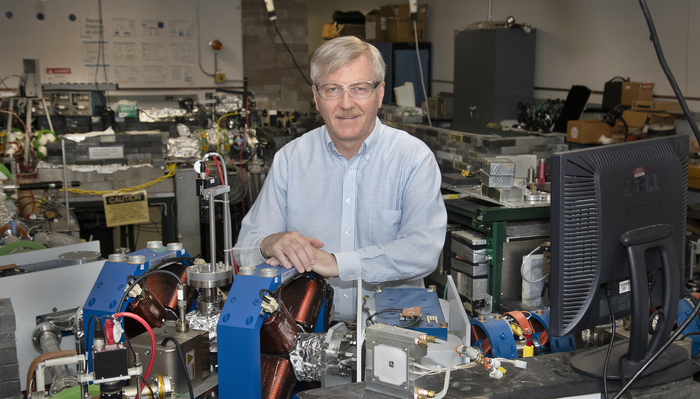UPTON, NY—The U.S. Department of Energy’s (DOE) Office of Science announced renewed funding for an Energy Frontier Research Center (EFRC) led by DOE’s Brookhaven National Laboratory to study “Molten Salts in Extreme Environments” (MSEE). This center, originally established in 2018, focuses on understanding the properties of molten salts—a class of materials with potential applications in energy technologies, particularly in nuclear power.

Credit: Brookhaven National Laboratory
UPTON, NY—The U.S. Department of Energy’s (DOE) Office of Science announced renewed funding for an Energy Frontier Research Center (EFRC) led by DOE’s Brookhaven National Laboratory to study “Molten Salts in Extreme Environments” (MSEE). This center, originally established in 2018, focuses on understanding the properties of molten salts—a class of materials with potential applications in energy technologies, particularly in nuclear power.
The renewal was one of 43 EFRC awards announced by DOE on August 25, 2022, with total funding of $400 Million at research institutions across the U.S. The EFRCs are designed to bring together multi-disciplinary scientific teams to tackle the toughest scientific challenges and remove roadblocks to advancing energy technologies.
“Meeting the Biden-Harris Administration’s ambitious climate and clean energy goals will require a game-changing commitment to clean energy—and that begins with researchers across the country,” said U.S. Secretary of Energy Jennifer M. Granholm. “[These] research projects … will strengthen the scientific foundations needed for the United States to maintain world leadership in clean energy innovation.”
What is a molten salt?
Molten salts are materials composed entirely of positively and negatively charged ions that exist in a liquid state under elevated temperatures. The Molten Salts in Extreme Environments EFRC explores the structural and dynamic properties of these materials in the bulk and at interfaces with other materials. The goal is to develop the understanding needed to predict and control these materials’ physical and chemical properties for a variety of applications. In nuclear energy, molten salts could be used as coolants for solid-fueled reactors, or they could serve simultaneously as the coolant and the solvent for liquid nuclear fuel. Other potential applications include nuclear fuel reprocessing, metallurgy, batteries, and solar thermal collection, transport, and storage.
“Molten salts are attractive for use as coolants in nuclear reactors because they can operate at higher, more efficient temperatures than water-cooled reactors while still at ambient pressure, and they have safety and sustainability advantages,” said Brookhaven Senior Chemist James Wishart, MSEE Director. “Our goal is to provide a scientific foundation for the successful deployment of molten salt reactors by understanding the chemical and collective behavior of molten salts and the materials dissolved in them, as well as how they affect the reactor materials that they contact. We’re gratified to receive renewed support, which will enable us to build on our previous work to advance molten salt science and continue to pioneer experimental and computational methods that will benefit the molten salt research community.”
Shannon Mahurin of DOE’s Oak Ridge National Laboratory (ORNL) will serve as MSEE Deputy Director. The team includes a total of 20 principal investigators (PIs), and partner institutions, including Idaho National Laboratory, Stony Brook University, and the Universities of Iowa, Michigan, Notre Dame, Tennessee, and Wisconsin. The project will receive a total of $13.3 million in funding over four years.
MSEE Accomplishments to date
Since the founding of MSEE, the team has been using specialized tools—including Brookhaven Lab’s National Synchrotron Light Source II (NSLS-II), the Chemistry Division’s Accelerator Center for Energy Research (ACER), and the Spallation Neutron Source at ORNL—and advanced computational methods to explore how molten salts behave at temperatures ranging from 300-1000 degrees Celsius (572-1832°F) and while exposed to intense radiation. The team has been developing cutting-edge computational approaches to simulate the atomic and electronic structure of molten salts and the chemical environments of materials dissolved in them. MSEE’s accomplishments so far include:
- In a series of studies combining computational simulations and x-ray scattering measurements, MSEE showed that the structure of reactor fuel salt on the atomic scale will be dominated by chains of multiply charged metal ion complexes that are separated by singly charged “spacer salt.” At higher temperature, the chains break into shorter pieces. Predicting the behavior and properties of fuel salt requires understanding how this structure changes with temperature and composition.
- The structure of the salt also determines how much solute (such as fissile uranium and fission products) the salt can hold and what chemical forms they exist in— critical information for reactor design. MSEE found that some metal ions can exist in multiple forms at the same time, and developed a ground-breaking approach combining detailed simulations and multiple experimental techniques to describe complex metal ion coordination states.
- MSEE has been examining the effects of radiation in molten and solidified salts. Radiation generates strongly oxidizing and reducing species, which leads in some cases to the formation of metal nanoparticles. Understanding the mechanisms of nanoparticle formation is important for long-term system reliability.
- MSEE developed an extensive set of high-temperature experimental instrumentation that it has shared with the wider molten salt research community at NSLS-II and elsewhere. For example, MSEE collaborated with engineers and scientists at the NSLS-II FXI beamline to build a furnace that enables real-time imaging of metal alloy corrosion processes in molten salt at high temperature (see figure below). MSEE has used this experimental setup to determine how corrosion mechanisms change with alloy and salt composition, and with temperature, which will lead to strategies to minimize corrosion in deployed reactor systems.
Other Brookhaven-linked EFRCs renewed
DOE also renewed funding for four additional EFRCs in which scientists from Brookhaven Lab play significant roles. Each of these centers was also renewed for four years:
Center for Mesoscale Transport Properties (m2M/t), led by Esther Takeuchi, Stony Brook University/Brookhaven Lab joint appointee. Lei Wang of Brookhaven Lab’s Interdisciplinary Science Department serves as the Lab’s PI.
Quantum Materials for Energy-Efficient Neuromorphic Computing (Q-MEEN-C), led by Ivan Schuller, University of California, San Diego. Yimei Zhu of Brookhaven’s Condensed Matter Physics & Materials Science Department is the Lab’s PI.
Programmable Quantum Materials (Pro-QM), led by Dmitri Basov, Columbia University, Valentina Bisogni of NSLS-II is the Brookhaven Lab PI.
Bioinspired Light-Escalated Chemistry (BioLEC), led by Greg Scholes, Princeton University. Matthew Bird of Brookhaven Lab’s Chemistry Division is the local PI.
At the same time, the Office of Science announced $140 Million in funding for other clean-energy research, $11 Million of which will go to projects at Brookhaven Lab on catalysts for water electrolysis, batteries, and bioproducts.
“It’s exciting to see the scientific community coming together to solve these critical issues that face us as a nation,” said James Misewich, Associate Laboratory Director for Energy and Photon Sciences at Brookhaven Laboratory.
NSLS-II and the Spallation Neutron Source are DOE Office of Science user facilities.
Brookhaven National Laboratory is supported by the Office of Science of the U.S. Department of Energy. The Office of Science is the single largest supporter of basic research in the physical sciences in the United States, and is working to address some of the most pressing challenges of our time. For more information, please visit science.energy.gov.
Follow @BrookhavenLab on Twitter or find us on Facebook.
Related Links
- DOE Announces $540 Million for Technologies to Transform Energy Production and Cut Emissions
- Brookhaven Awarded $11M in Funding to Support Clean Energy Research




